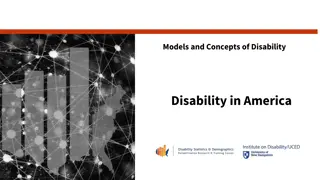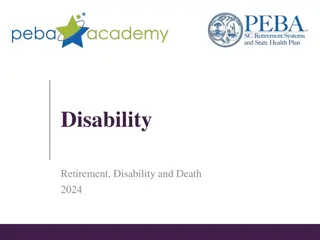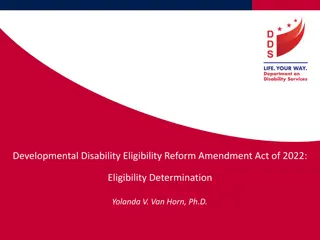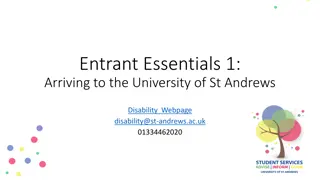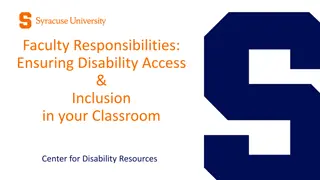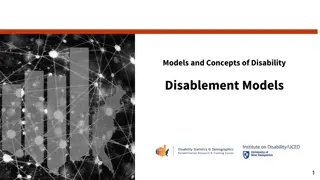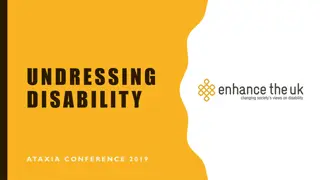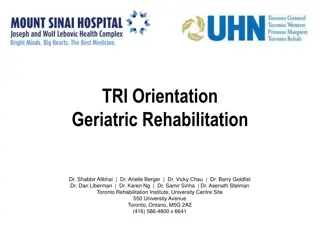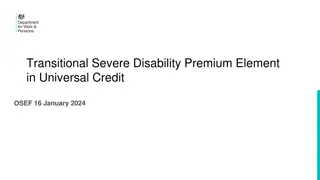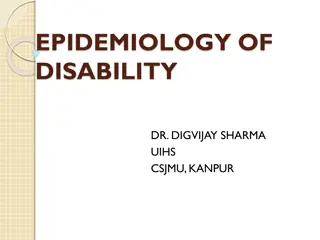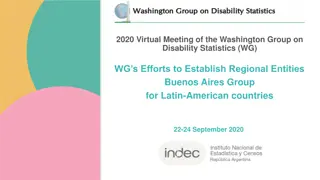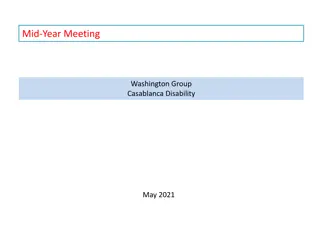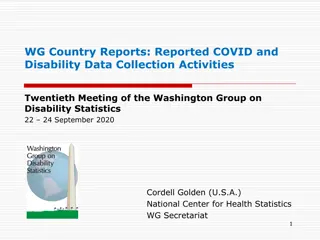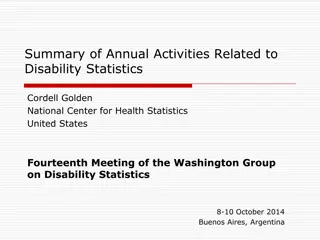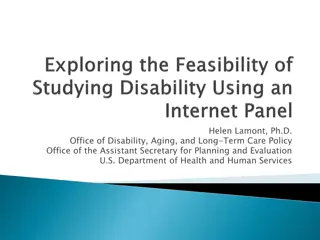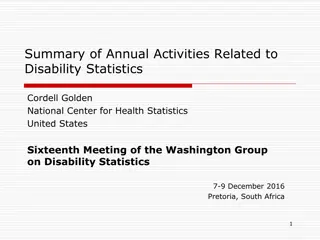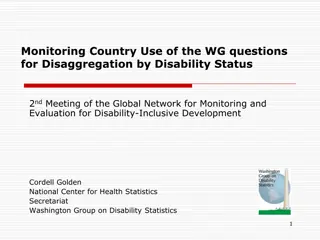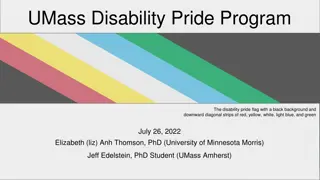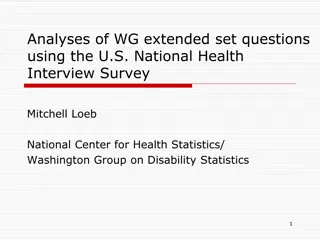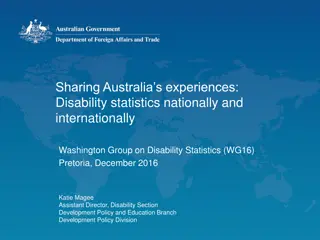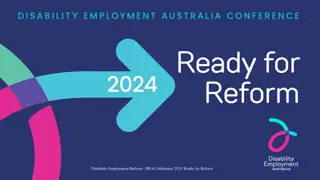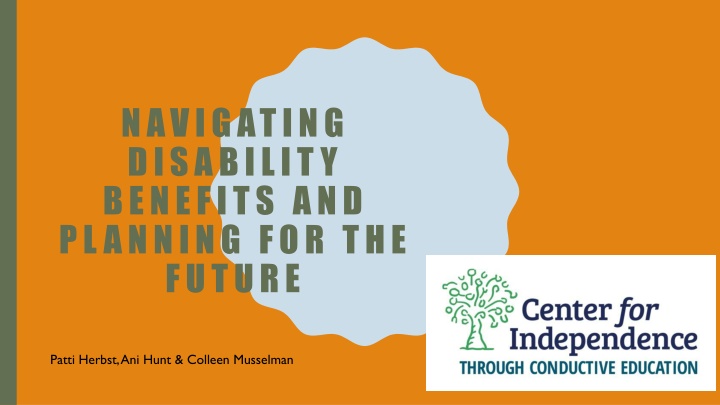
Navigating Disability Benefits and Planning for the Future - Helpful Insights
Discover essential information on disability benefits and future planning for individuals with disabilities. Learn about the Department of Rehabilitation Services, Prioritization of Urgency for Need for Services (PUNS), Home-based services, Medicaid Waiver Program, and more to help you make informed decisions.
Download Presentation

Please find below an Image/Link to download the presentation.
The content on the website is provided AS IS for your information and personal use only. It may not be sold, licensed, or shared on other websites without obtaining consent from the author. If you encounter any issues during the download, it is possible that the publisher has removed the file from their server.
You are allowed to download the files provided on this website for personal or commercial use, subject to the condition that they are used lawfully. All files are the property of their respective owners.
The content on the website is provided AS IS for your information and personal use only. It may not be sold, licensed, or shared on other websites without obtaining consent from the author.
E N D
Presentation Transcript
NAVIGATING DISABILITY BENEFITS AND PLANNING FOR THE FUTURE Patti Herbst, Ani Hunt & Colleen Musselman
BENEFITS MY DISABLED CHILD MAY BE ELIGIBLE FOR (WHEN AND WHY TO APPLY) Today we will be discussing Navigating Disabilities services can be tricky. We are here to help! What is the Department of Rehabilitation Services (DRS)? What is Prioritization of Urgency For Need for Services. (PUNS)? What is Home based services?
WHICH PROGRAM IS RIGHT FOR YOUR CHILD? People with disabilities are fortunate to have services available to them. There are 2 programs available. An individual may only be enrolled in 1 of these programs. Both programs have pros and cons. Programs: 1. PUNS Prioritization of Urgency of Need for Services Apply for PUNS NOW Puns is for all people with developmental disabilities. Puns is for everyone who may need help from the government to pay for developmental disability services now and in the future. To get on the PUNS list, one must have a developmental disability (DD). The Independent Service Coordination Agency (ISC) will determine eligibility. PUNS is the first step toward getting services in Illinois. If you are not on the PUNS list, you are not on the waiting list for services. Apply for PUNS immediately in order to be considered and be on the list.
PUNS CONTD PUNS Categories: Emergency - You need immediate services Critical - You will need services within 1 year Planning - You will need services in 1 to 5 years To find your ISC, Independent Service Coordination Agency , you can call Illinois Life Span at 1-800-588- 7002. You can also call DHS at 1-888-DD-PLANS. When your PUNS survey is done, you are on the list. This doesn t mean that you will get the services you need. It just means that you have made the first step. Some of the services that PUNS provides: In-Home Supports
MEDICAID WAIVER PROGRAM HOME BASED SERVICES The other option for services is 2. MEDICAID WAIVER PROGRAM-HOME BASED SERVICES: A waiver is a program that provides services that allow individuals to remain in their own homes or live in a community setting, instead of in an institution. Illinois has nine HCBS waivers. Each waiver is designed for individuals with similar needs and offers a different set of services. Eligible candidates must have a physical disability and must be 18. Services provided: Personal care assistant: PT and OT Services Meals
BENEFITS MY DISABLED CHILD MAY BE ELIGIBLE FOR (WHEN AND WHY TO APPLY) Supplemental Security Income (Managed by Social Security Administration Income Based) NOT TO BE CONFUSED WITH SOCIAL SECURTY PROGRAM! Social Security Disability Income SSDI Medicaid Medicaid Waiver Program- Home based services Supplemental Nutrition Assistance Program (SNAP) PACE/Paratransit Tuition Assistance (DRS Vocational services /PELL Grant)
DHS/DRS DHS's Division of Rehabilitation Services is the state's lead agency serving individuals with disabilities. DRS works in partnership with people with disabilities and their families to assist them in making informed choices to achieve full community participation through employment, education, and independent living opportunities. Qualify for DRS at age 18 or a high school graduate.
MEDICAID Illinois Healthcare and Family Service (HFS), the State Medicaid Agency A component of the DHS-DRS Home Services Program (HSP) Operating Agency: Illinois Department of Human Services-Division of Rehabilitation Services (DHS-DRS) Managed Care Organization: For those persons receiving Medical services through a managed care organization, see contact information and links below Eligible Population: Individuals with disabilities who are under age 60 at the time of application and are at risk of placement in a nursing facility Individuals 60 years or older, who began services before age 60, may choose to remain in this waiver Eligibility Criteria: U S. citizen or legal alien Resident of the State of Illinois Under age 60 at time of application
SOCIAL SECURITY SSI/SSDI Several federal benefits programs provide financial assistance to seniors and persons living with disabilities.Supplemental Security Income (SSI) and Social Security Disability Insurance (SSDI) are two of the most common programs from the Social Security Administration (SSA). What Is Supplemental Security Income (SSI)? SSI provides minimum basic financial assistance to older adults and persons with disabilities (regardless of age) with very limited income and resources. Federal SSI benefits from the Social Security Administration are often supplemented by state programs. What Is Social Security Disability Insurance (SSDI)? SSDI supports individuals who are disabled and have a qualifying work history, either through their own employment or a family member (spouse/parent). It s always better to have a work history. What Is the difference between SSI and SSDI? The major difference is that SSI determination is based on age/disability and limited income and resources, whereas SSDI determination is based on disability and work credits. In addition, in most states, an SSI recipient will automatically qualify for health care coverage through Medicaid. A person with SSDI will automatically qualify for Medicare after 24 months of receiving disability payments .
SSI/SSDI The SSDI program pays benefits to you and certain family members if you are insured. This means that you worked long enough and recently enough - and paid Social Security taxes on your earnings. The Supplemental Security Income (SSI) program pays benefits to adults and children with disabilities who have limited income SSI is a Needs Based Program. In order to receive SSI your countable resources must not be worth more than $2,000 for an individual or $3,000 for a couple. This is referred to as the resource limit. It is important to have a work history for eligibility for SSDI After working for 10 quarters, an individual is eligible for Medicare which is more widely accepted by healthcare providers. While these two programs are different, the medical requirements are the same. If you meet the non-medical requirements, monthly benefits are paid if you have a medical condition expected to last throughout your life. Both programs are managed by the Social Security Administration
SOCIAL SECURITY SSI/SSDI CONTINUED Factor SSI SSDI Age (65+) OR blindness (any age) OR disability (any age) AND limited/no income and resources Disability AND sufficient work credits through own/family employment Eligibility based on 6th full month of disability; 6-month period begins with the first full month after the date SSA decides the disability began 1st full month after the date the claim was filed or, if later, the date found eligible for SSI When benefits begin Average benefit (monthly) $577 (as of Nov. 2020) $1,128 (as of Nov. 2020) $794/$1,191 (single/married couple) in 2021 (based on income) Maximum benefit (monthly) $3,148 in 2021 (based on work history) Automatically qualifies for Medicaid upon
WHO IS ELIGIBLE TO RECEIVE SNAP BENEFITS? Who can receive these services? Most households with low income can get SNAP benefits. The rules are complex, so all of the details are not here. The most important factors which determine the amount of, and eligibility for, SNAP benefits are: income and expenses; the number of persons who live and eat together Use the SNAP Eligibility Calculator to give an estimate of possible benefits. This is only an estimate. Your application must be reviewed by IDHS staff at the Family Community Resource Center. If you apply for benefits and are eligible, you will receive a notice of your eligibility. Income A household might be eligible to receive SNAP benefits if their monthly gross income does not exceed the gross income limits shown below. SNAP Program Income and Benefit Amounts (English Version) - DHS 124
HOW MUCH DO I RECEIVE EACH MONTH? The monthly SNAP Benefit amount depends on the number of people in the "SNAP unit" and the monthly income available to meet needs after the caseworker subtracts the allowable deductions (such as rent and utilities) from gross income. The chart below shows the highest monthly benefit by household size.Depending on income, this amount could be less. SNAP Program Income and Benefit Amounts (English Version) - DHS 124 SNAP Program Income and Benefit Amounts (Spanish Version) - DHS 124S
DRS VOCATIONAL SERVICES Every state gets money from the federal government to help people with disabilities who want to get or keep a job. The Division of Rehabilitation Services (DRS) uses this money to run the VR program to help people get or keep a job. Who Can Qualify for VR Services? You can qualify if you have a disability and need services from DRS to get or keep a job. You do not qualify if your disability makes it too hard for you to work even with VR services. If you do not want to get or keep a job, you don't qualify.
DRS VOCATIONAL SERVICES (VR) What is the purpose of this service? Vocational services helps people with disabilities find and keep jobs. The goal is to help customers find quality employment that pays a living wage and offers a chance for advancement. The staff talks to people about their employment needs and help them find a job or get ready to go to work. They also make sure that people have the supports they need to stay on the job. VR counselors help high school students who have disabilities plan for their futures after high school graduation through our Transition and STEP programs. The Work Incentive Planning and Assistance Program helps people who receive SSDI/SSI benefits understand how working will affect their benefits. The Supported Employment Program (SEP) serves eligible people with significant disabilities who want to go to work and need on-going support services to succeed on the job. How to apply? Use the online Rehabilitation Services Web Referral to refer yourself or someone else for services. Use the DHS Office Locator and search for Rehabilitation Services to find the nearest local office or call toll-free: (800) 843-6154 (Voice, English or Espa ol) or (800) 447-6404 (TTY).
PLANNING FOR COLLEGE DRS TUITION ASSISTANCE Your child s IEP continues and will now be known as : Individualized Employment Plan DRS has the ability to approve federal Pell Grants for college tuition for people with disabilities. http://www.dhs.state.il.us/onenetlibrary/12/documents/Forms/IL4 88-2460.pdf
WORK INCENTIVES What is a Work Incentive? Special rules make it possible for people with disabilities receiving Social Security or Supplemental Security Income (SSI) to work and still receive monthly payments and Medicare or Medicaid. Social Security calls these rules "work incentives." Below are the rules that apply under each program. What is the Ticket to Work Program? Social Security's Ticket to Work Program supports career development for Social Security disability beneficiaries aged 18 through 64 who want to work. The Ticket to Work Program is free and voluntary. The Ticket to Work Program helps people with disabilities progress toward financial independence.
WORKING WHILE RECEIVING BENEFITS How much can I earn while still receiving disability benefits? Substantial Gainful Activity (SGA) The SGA amount for persons with disabilities other than blindness is $1,310 per month in 2021. For persons who are blind, the amount of earnings that indicate SGA is $2,190 per month in 2021. Further information is available in the section How We Decide If You Are Disabled. Trial Work Period (TWP) Months The monthly earnings amount that we use to determine if a month counts as a TWP month is $940 per month in 2021. Details on the TWP are in the sectionTrial Work Period.
PACE PARATRANSIT Pace operates a fixed route bus system which is entirely accessible to people with disabilities and our sister agencies--CTA and Metra--offer accessible transit service as well.For senior citizens and people with disabilities, fixed route is a less expensive way to get around your community and gives you the freedom to travel without arranging a ride in advance. The Regional Transportation Authority offers a training program for those who wish to learn how to ride fixed route. You must live within of a mile of a regularly scheduled Pace bus route. Most townships also have transportation services for people with disabilities and seniors. HTTPS://WWW.PACEBUS.COM/SITES/DEFAULT/FILES/2021- 09/ADA%20COMBO%20ENGLISH%209-3-21.PDF PACEBUS.COM/ADA
ADDITIONAL ITEMS Special Needs Trust Illinois Able Account https://illinoisable.com

